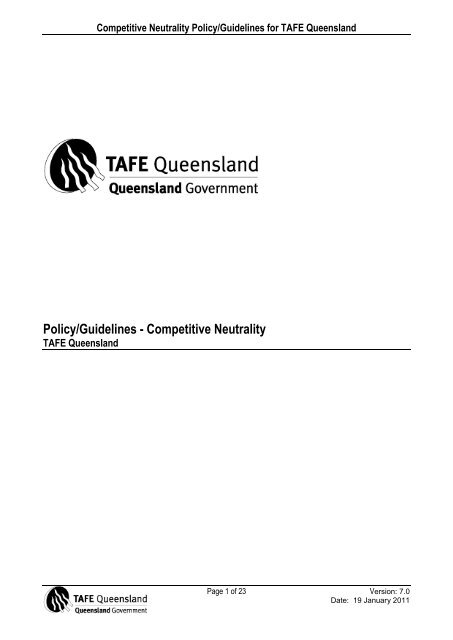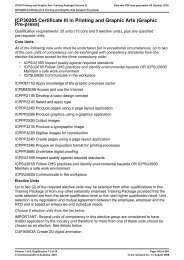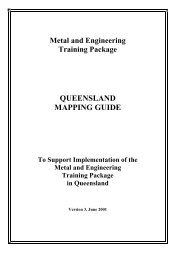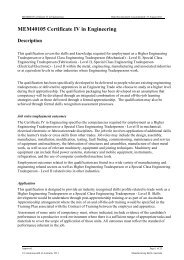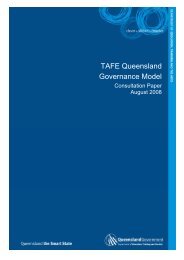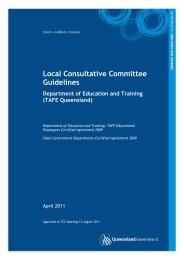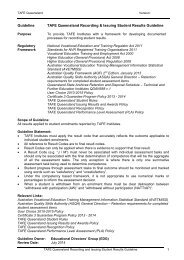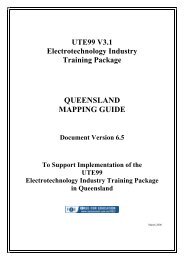TAFE Queensland Competitive Neutrality Guidelines - Training ...
TAFE Queensland Competitive Neutrality Guidelines - Training ...
TAFE Queensland Competitive Neutrality Guidelines - Training ...
You also want an ePaper? Increase the reach of your titles
YUMPU automatically turns print PDFs into web optimized ePapers that Google loves.
<strong>Competitive</strong> <strong>Neutrality</strong> Policy/<strong>Guidelines</strong> for <strong>TAFE</strong> <strong>Queensland</strong>Policy/<strong>Guidelines</strong> - <strong>Competitive</strong> <strong>Neutrality</strong><strong>TAFE</strong> <strong>Queensland</strong>Page 1 of 23 Version: 7.0Date: 19 January 2011
<strong>Competitive</strong> <strong>Neutrality</strong> Policy/<strong>Guidelines</strong> for <strong>TAFE</strong> <strong>Queensland</strong>Table of Contents2. VERSION CONTROL .............................................................................................................. 33. INTRODUCTION ..................................................................................................................... 43.1 National Competition Policy & <strong>Competitive</strong> <strong>Neutrality</strong>...................................................... 43.2 Full Cost Pricing Policy ................................................................................................... 44. <strong>TAFE</strong> QUEENSLAND - COMPETITIVE NEUTRALITY IMPLEMENTATION ........................... 54.1 Background ..................................................................................................................... 54.2 Scope of Implementation of <strong>Competitive</strong> <strong>Neutrality</strong> ......................................................... 54.3 CN Implementation for <strong>TAFE</strong> <strong>Queensland</strong> ...................................................................... 64.4 Elements of <strong>Competitive</strong> <strong>Neutrality</strong> Adjustment ............................................................... 64.5 Full Cost Pricing Implications .......................................................................................... 84.5.1 Full Cost Pricing Elements ..................................................................................................... 84.5.2 <strong>Competitive</strong> <strong>Neutrality</strong> and the Pricing Decision: ................................................................... 85. THE COMMERCIAL COST PRICE MODEL ............................................................................ 96. FEEDBACK & SUPPORT ....................................................................................................... 97. COMPLAINTS MECHANISM .................................................................................................. 97.1 Commercial-in-confidence ............................................................................................ 108. MAINTENANCE & REVIEW .................................................................................................. 109. ADDITIONAL DOCUMENTATION ........................................................................................ 11ATTACHMENT 1 – DEFINING FULL COST PRICE ELEMENTS ................................................ 12Purpose ................................................................................................................................. 12Accurate Cost Attribution........................................................................................................ 12Cost Examples ....................................................................................................................... 121. Delivery Expenditure ............................................................................................................ 122. Delivery Overheads .............................................................................................................. 133. Institute Overheads .............................................................................................................. 14Business Planning Process & Full Cost Pricing ...................................................................... 15ATTACHMENT 2 – IMPLEMENTING THE COMMERCIAL COST PRICE MODEL ..................... 16About the Model ..................................................................................................................... 16Application of the Model ......................................................................................................... 16Purpose of the Model ............................................................................................................. 16General Notes ........................................................................................................................ 16Instructions to set up the Model for your Institute ................................................................... 17Getting Started – Enter Costs ................................................................................................ 17How the CN Adjustment Works ..................................................................................... 19Determining a Price for Corporate FFS Programs and Tenders ............................................. 20Determining a Price for Single Subscriber Programs .............................................................. 20The Final Steps ...................................................................................................................... 21ATTACHMENT 3 – FULL COST PRICE AUDIT CHECKLIST ...................................................... 22Purpose ................................................................................................................................. 22Cost Price Model: ................................................................................................................... 22Pre-Planning: ......................................................................................................................... 22Pre-Determined Cost Elements ..................................................................................... 22Other Items: .................................................................................................................. 22Developing a Cost Price Schedule: ........................................................................................ 23Negotiation ............................................................................................................................. 23Reporting & Review ............................................................................................................... 23Page 2 of 23 Version: 7.0Date: 19 January 2011
<strong>Competitive</strong> <strong>Neutrality</strong> Policy/<strong>Guidelines</strong> for <strong>TAFE</strong> <strong>Queensland</strong>1. Sign-offThese Explanatory Notes have been reviewed and endorsed by the Chief Financial Officer,the General Manager (Planning and Purchasing), the Chair (<strong>TAFE</strong> Directors <strong>Queensland</strong>)and the Deputy Director-General (see document CFO 577).Lynette LambChief Financial Officer Sighted and signed on 23 May 2005Robert McAulayGeneral ManagerPlanning and Purchasing Sighted and signed on 23 May 2005Deb DalyChair, <strong>TAFE</strong> Directors <strong>Queensland</strong> Sighted and signed on 26 May 2005Chris RobinsonDeputy Director-General Sighted and signed on 3 June 20052. Version ControlThis document is subject to change control. All modifications to this Policy must be recordedbelow.VersionDateResponsibleOfficer1.0 First draft written 14 December 2001 Patricia Ingall1.1 Formatted and updated 17 December 2001 Michelle Lanzelin1.2 Updated with preliminary comment 03 January 2002 Michelle Lanzelin2.0 Distributed for formal feedback 10 January 2002 Patricia Ingall2.1 Revised & amended 07 February 2002 Patricia Ingall2.2 Updated to include Institute feedback 07 February 2002 Patricia Ingall2.3 Updated to include Internal Audit feedback 08 February 2002 Patricia Ingall3.0 Distributed to TQE for endorsement 08 February 2002 Patricia Ingall3.1 Updated with feedback from FMIP 15 February 2002 Patricia Ingall4.0 Final Version submitted to SteeringCommittee15 February 2002 Patricia Ingall5.0 Updated with additional comments fromInternal Audit, Treasury and Steering22 February 2002 Patricia IngallCommittee. Final Version for Signature.6.0 Updated based on 2003-04 data 31 March 2005 Michael Cashman7.0 Updated based on 2008-09 data 19 January 2011 Robert EylesPage 3 of 23 Version: 7.0Date: 19 January 2011
<strong>Competitive</strong> <strong>Neutrality</strong> Policy/<strong>Guidelines</strong> for <strong>TAFE</strong> <strong>Queensland</strong>3. INTRODUCTION3.1 National Competition Policy & <strong>Competitive</strong> <strong>Neutrality</strong>In 1995 the Commonwealth and all State and Territory Governments agreed to implement<strong>Competitive</strong> <strong>Neutrality</strong> (CN) policies as part of the National Competition Policy Reformpackage. The aim of CN is to promote efficient competition between public and privatebusinesses by removing any advantages and disadvantages that may accrue to a business byvirtue of its Government ownership.In essence, in order to achieve competitive neutrality, Government businesses are required to:charge prices that fully reflect costs;pay, or include an allowance for, government taxes and charges such as Goods and ServicesTax, Capital Gains Tax, Payroll Tax, Stamp Duties and local government rates;pay commercial rates of interest on borrowing's;obtain a rate of return on assets;generate commercially acceptable profits; andcomply with the same regulations that apply to private businesses (such as the TradePractices Act and planning and environmental laws).The principle of competitive neutrality does not apply to competitive advantages arising fromfactors such as business size, skills, location or customer loyalty. Any edge in competitionshould be the result of superior management and operations.However, Government businesses are not to be commercially disadvantaged (or advantaged) byrequirements to deliver „non-commercial‟ services, or to provide services at subsidised rates toparticular groups of consumers.Generally speaking, competitive neutrality is best achieved by restructuring a Governmentbusiness so that its‟ Corporate structure, and its‟ incentives, resemble those in the privatesector. However, the application of competitive neutrality is always subject to the proviso thatthe benefits outweigh the associated costs. Where restructure is not feasible, as has beendetermined for <strong>TAFE</strong> <strong>Queensland</strong>, then the adoption of an appropriate pricing policy (ie, FullCost Pricing) is a viable alternative.3.2 Full Cost Pricing PolicyThe <strong>Queensland</strong> Full Cost Pricing (FCP) Policy aims to achieve competitive neutrality betweenpublic and private sector businesses by ensuring that prices charged by governmentbusinesses reflect a similar cost structure to that faced by private sector competitors, so thatboth sectors are subject to the same pressures from competition.Whilst this aim is best achieved by ensuring that prices, in all situations where a governmentbusiness is competing, are based on the full cost of supplying a product, the policy does allowsufficient flexibility for government businesses to price in a competitive manner according tomarket conditions. For example, the policy permits the setting of "loss-leader" prices providedthat a prescribed rate of return is achieved in the medium term.Page 4 of 23 Version: 7.0Date: 19 January 2011
<strong>Competitive</strong> <strong>Neutrality</strong> Policy/<strong>Guidelines</strong> for <strong>TAFE</strong> <strong>Queensland</strong>4. <strong>TAFE</strong> QUEENSLAND - COMPETITIVE NEUTRALITY IMPLEMENTATION4.1 BackgroundIn April 1997 Treasury published guidelines for conducting a Public Benefits Test in order toassess the benefits and costs of introducing CN to government businesses.Coopers and Lybrand were commissioned to undertake a Base Case Assessment. Stage 1 of aPublic Benefits Test was completed by ETM Solutions in 1999 and PricewaterhouseCoopersundertook Stage 2 later that same year. Their final report was presented in May 2000.Following a review of the outcomes by the <strong>TAFE</strong> <strong>Queensland</strong> National Competition PolicyImplementation Steering Committee, Cabinet endorsed a number of recommendations for theimplementation of CN in <strong>TAFE</strong> <strong>Queensland</strong> by February 2002.An analysis of the advantages and disadvantages <strong>TAFE</strong> <strong>Queensland</strong> has by virtue of being ownedby government was undertaken and a <strong>Competitive</strong> <strong>Neutrality</strong> adjustment was developed forthe whole of <strong>TAFE</strong> <strong>Queensland</strong>. This model for calculating a <strong>Competitive</strong> <strong>Neutrality</strong>Adjustment is based on the principles and policies of <strong>Competitive</strong> <strong>Neutrality</strong>, findings from thePublic Benefits Test and from a model implemented by <strong>TAFE</strong> in Victoria.4.2 Scope of Implementation of <strong>Competitive</strong> <strong>Neutrality</strong>In <strong>TAFE</strong> <strong>Queensland</strong>, competitive neutrality principles will be applied through the implementationof Full Cost Pricing. Full Cost pricing will be achieved by the full allocation of costs for thedelivery of programs when competing directly against private providers, in addition to theapplication of a <strong>Competitive</strong> <strong>Neutrality</strong> Adjustment percentage, prior to determining anappropriate price.The principles of <strong>Competitive</strong> <strong>Neutrality</strong> will apply to:all <strong>Competitive</strong> Purchasing Programs (CPP) when competing head-to-head with a privateprovider; andall corporate and single subscriber Fee-for-Service (FFS) activities, when competing head-toheadwith a private provider.<strong>Competitive</strong> <strong>Neutrality</strong> will not apply to the following:User Choice programs;Profile Funded programs;Overseas/International Student programs;FFS activities conducted internationally;Direct approaches for course/service delivery (where private providers will not be competing);Adult Community Education (ACE) activities;Activities where the only competition is from other <strong>TAFE</strong> Institutes;Government Service Obligations.The aim is to ensure that Institutes can go in honestly to win business on an equal footing withcompeting private providers, and that the process is transparent and fair to all partiesconcerned.Page 5 of 23 Version: 7.0Date: 19 January 2011
<strong>Competitive</strong> <strong>Neutrality</strong> Policy/<strong>Guidelines</strong> for <strong>TAFE</strong> <strong>Queensland</strong>4.3 CN Implementation for <strong>TAFE</strong> <strong>Queensland</strong>In order to achieve <strong>Competitive</strong> <strong>Neutrality</strong> in <strong>TAFE</strong> <strong>Queensland</strong>, one generic CN Adjustmentpercentage has been determined, based on the calculation of advantages and disadvantageswith private sector counterparts. Where appropriate, Institutes will apply this percentage whenpricing their commercial products.The following tools have been developed to assist implementation:CN Adjustment Model - Explanatory Notes (explaining the workings used to calculate anadjustment percentage for <strong>TAFE</strong> <strong>Queensland</strong>);CN Adjustment Percentage (base data and final figure for implementation);Policy/<strong>Guidelines</strong> for CN Implementation in <strong>TAFE</strong> <strong>Queensland</strong> (this document); andAn example of a Commercial Cost Price Model for <strong>TAFE</strong> <strong>Queensland</strong>.It is not mandatory for all Institutes to use the example Cost Price model. Those Instituteswhich already have a cost price model implemented will only be affected in terms of applyingcompetitive neutrality principles and adding the <strong>Competitive</strong> <strong>Neutrality</strong> Adjustment percentagewithin their existing models.Please Note: Use of a generic Cost Price model does NOT mean that there will be one <strong>TAFE</strong>price for <strong>TAFE</strong> business. Institutes must maintain pricing flexibility in order to meet theirindividual business needs and the specific needs of their customers.4.4 Elements of <strong>Competitive</strong> <strong>Neutrality</strong> AdjustmentThe elements of the <strong>Competitive</strong> <strong>Neutrality</strong> Adjustment include:Page 6 of 23 Version: 7.0Date: 19 January 2011
<strong>Competitive</strong> <strong>Neutrality</strong> Policy/<strong>Guidelines</strong> for <strong>TAFE</strong> <strong>Queensland</strong>Element: Description:Taxes and Tax EquivalentsStamp Duty includes calculations for Stamp Duty payable on: Registration of a Motor Vehicle (bus, motorcycle, forklift, bobcat etc)Stamp Duty Insurance (Policies Property Insurance, General Liability Insurance, PersonalAccident Insurance, Marine Insurance and an estimate of ProfessionalIndemnity Insurance premiums).Adjustment required for Land Tax payable on unimproved value of freehold landLand Taxfor each Institute as per Land Tax Act 1915Debt ManagementCalculation based on interest that would be payable to <strong>TAFE</strong> <strong>Queensland</strong> oroverdraft interest that would be payable by <strong>TAFE</strong> <strong>Queensland</strong> based on cashInterest on bankbalances as detailed in the Balance Sheet (<strong>TAFE</strong> Qld Institutes do not holdbalancesseparate bank accounts therefore cash balances in the Balance Sheet havebeen utilised).Interest onBorrowingsCapital Structure<strong>TAFE</strong> Qld currently sources loans from <strong>Queensland</strong> Treasury Corporation withlower interest rates than those offered by other financial institutions.Debt vs Equity Ratio adjustment. Increased interest payments associated withthe increased level of debt if the debt ratio was increased.Industrial Relations The salary structure for <strong>TAFE</strong> <strong>Queensland</strong> Teachers & Tutors is set by the<strong>TAFE</strong> Teachers‟ Award – State and the <strong>TAFE</strong> Enterprise BargainingAgreement. As it is not possible to obtain accurate information regarding private sectorSalariessalary rates, the Educational Services (Post Secondary Education) award2010 has been considered to be an appropriate benchmark for private sectorcomparatives. This award has salary rates that are generally lower thangovernment awards and also has a requirement for higher student contacthours.Superannuation entitlements for <strong>TAFE</strong> Qld employees are in excess of thoseSuperannuationpaid to private sector employees.Under Directive 19/99 – Locality Allowances, <strong>TAFE</strong> Qld public servants andLocality Allowance teachers in regional and remote locations are paid a fortnightly localityallowance. This is not the case in the private sector.Cross subsidisationCross subsidisation Identification of cross subsidisation where possibleWhole of Government Insurance Scheme Payment made to the Qld Govt Insurance Fund by <strong>TAFE</strong> <strong>Queensland</strong>covering – Property, General/Public Liability, Personal Accident and Marine <strong>TAFE</strong> <strong>Queensland</strong> receives subsidisation for this insurance from QldInsuranceTreasury (factored as a competitive advantage) In addition, the cost of Professional Indemnity Insurance has been estimatedto reflect competitive neutralityPricing Decision Adjustments Under FCP policy, income taxes are to be explicitly considered as part of thepricing decision. This treatment has been adopted on the basis that incometax expense is a direct function of the price charged for a product or service.Income Tax (PAYG) Company Tax of 30% is administered under the Income Tax Assessment Actand is imposed on the profit determined in accordance with this Act (<strong>TAFE</strong>Qld is currently exempt).Return on Equity<strong>TAFE</strong> Institutes are advantaged as there is no formal requirement to deliver anyreturn on equity invested. To compensate for this, a return on equity rate of6% before tax has been applied. This rate is currently used by <strong>Queensland</strong>Treasury as the required rate of return from its commercial business units.Page 7 of 23 Version: 7.0Date: 19 January 2011
<strong>Competitive</strong> <strong>Neutrality</strong> Policy/<strong>Guidelines</strong> for <strong>TAFE</strong> <strong>Queensland</strong>4.5 Full Cost Pricing Implications4.5.1 Full Cost Pricing ElementsTo achieve competitive neutrality in <strong>TAFE</strong> <strong>Queensland</strong>, Full Cost Pricing will comprise the followingelements:Delivery Costs:Labour – costs incurred for delivery and specific management of the course/projectMaterials – all fixed and variable costs for students and deliveryOverheads Costs:Program overheads – for the management of the business‟ units activitiesInstitute overheads – for costs incurred by the unit and borne elsewhere in the InstitutePricing Decision:Application of <strong>Competitive</strong> <strong>Neutrality</strong> Adjustment +Consideration of Market Factors +Business Decision (Profit/Loss) =FINAL PRICE TO CLIENTPlease refer to Attachment 1 - “Defining Full Cost Pricing Elements” for more specific informationand cost examples.4.5.2 <strong>Competitive</strong> <strong>Neutrality</strong> and the Pricing Decision:The calculation of a <strong>Competitive</strong> <strong>Neutrality</strong> Adjustment will determine <strong>TAFE</strong> <strong>Queensland</strong> businessactivities to be either:<strong>Competitive</strong>ly advantaged, in which case a positive percentage CN adjustment will be applied;or<strong>Competitive</strong>ly disadvantaged, in which case a negative percentage CN adjustment will apply.+If <strong>TAFE</strong> is competitivelyadvantaged:-If <strong>TAFE</strong> is competitively disadvantaged:1. The CN Adjustment is applied and the suggested priceis increased.2. A business decision can be made to change the price tomeet market conditions.3. The price quoted is the price paid.1. The CN Adjustment is applied and the suggested priceis decreased.2. A business decision can be made to change the price tomeet market conditions.3. The price quoted is the price paid.As well as the true cost of delivery, examples of business considerations which could influence thefinal price of a product include:Level of demand of services;Current market value of the product;Level of competition between service providers; andShort term pricing strategies involving use of "loss-leader".The Full Cost Pricing policy permits the setting of "loss-leader" prices provided that a rate of returnis achieved in the medium term. Therefore, <strong>TAFE</strong> <strong>Queensland</strong> must not sustain losses overthe medium term: the term over which the rate of return is to be met should be not more thanthree years.Page 8 of 23 Version: 7.0Date: 19 January 2011
<strong>Competitive</strong> <strong>Neutrality</strong> Policy/<strong>Guidelines</strong> for <strong>TAFE</strong> <strong>Queensland</strong>At most times, it is expected that Institutes would not be wishing to incur a loss (unlesspurposefully setting a loss leader), and so prices would be adjusted according to currentmarket and other business influences. If any party were to claim that <strong>TAFE</strong> had unjustly usedgovernment ownership as an advantage to gain business, <strong>TAFE</strong> could demonstrate that<strong>Competitive</strong> <strong>Neutrality</strong> is a factor which was actively considered as part of the pricing decision,and that the business was won fairly. Implementing Full Cost Pricing and a <strong>Competitive</strong><strong>Neutrality</strong> adjustment means that there is a conscious effort and intent not to disadvantageprivate providers.It is imperative that all business decisions and the reasoning behind them are clearly documentedand that approval for variation is sought from the delegated authority. Remember that you arecompeting against private providers for whom this business is a livelihood, and it is importantthat they are not disadvantaged through inappropriate pricing decisions.A Complaints mechanism is in place for parties who consider that competitive neutrality principlesare not adequately implemented. For more information, please refer to Section 7 -“Complaints Mechanism”.5. THE COMMERCIAL COST PRICE MODELAn example Cost Price Model for use by Institute commercial business units has been developedusing Microsoft Excel. This model is distributed to all <strong>TAFE</strong> <strong>Queensland</strong> Institutes in order toassist with the implementation of Full Cost Pricing and <strong>Competitive</strong> <strong>Neutrality</strong>. Institutes arewelcome to adapt this model to suit their individual needs.However, implementation of this particular model (Excel version) is not compulsory. Institutes arerequired to either use the example or amend their own models to include Full Cost Pricingelements and a CN adjustment in order to determine appropriate prices for commercialproducts. Institutes are reminded that the usual audit processes will apply.For more information on using the example Commercial Cost Price Model, please refer toAttachment 2 – “Implementing the Commercial Cost Price Model”.6. FEEDBACK & SUPPORTAll feedback and constructive suggestions for improving this policy are welcome. Resolution willbe sought for relevant queries, concerns and issues raised with regard to the implementationof competitive neutrality for <strong>TAFE</strong> <strong>Queensland</strong>. These will be logged, and will input into thereview process as indicated in Section 8 – “Maintenance & Review”.Should you wish to provide feedback, require additional information, or have any queries relating tothe application of competitive neutrality for <strong>TAFE</strong> <strong>Queensland</strong> or clarification of issues, pleasecontact the Legal & Risk Management unit, Corporate Capability Development.You may also wish to refer to Section 9 – “Additional Documentation”.7. COMPLAINTS MECHANISMAn important part of competitive neutrality arrangements is the complaint mechanism. Complaintsgenerally fall into three groups:That a government business is not complying with CN arrangements;Page 9 of 23 Version: 7.0Date: 19 January 2011
<strong>Competitive</strong> <strong>Neutrality</strong> Policy/<strong>Guidelines</strong> for <strong>TAFE</strong> <strong>Queensland</strong>That the CN arrangements are ineffective in removing advantages arising from governmentownership; orThat a government business is not subject to CN arrangements when it should be.Any individual or organisation (including a government body) may lodge a complaint. Complaintscan be made directly to the Institute Director; the Chair, <strong>TAFE</strong> <strong>Queensland</strong>; the Director-General, Department of Employment and <strong>Training</strong>; or in writing to the Department ofEmployment and <strong>Training</strong>.In addition, there is a standard range of alternate complaint mechanisms in place, including theOffice of the Ombudsman and Ministerial correspondence. However, complainants areencouraged to contact the relevant Institute Director/s for resolution in the first instance.Institutes are directed to ensure all complaints received are attended to promptly.The <strong>Queensland</strong> Competition Authority (QCA) was established to receive, investigate and report toMinisters on complaints against government agencies carrying on significant businessactivities otherwise than in accordance with the principle of competitive neutrality. However,the QCA will not handle complaints against <strong>TAFE</strong> <strong>Queensland</strong> business units, as <strong>TAFE</strong><strong>Queensland</strong> has not been gazetted as a 'Significant Business Activity' under Section 39 of the<strong>Queensland</strong> Competition Authority Act 1997.Further information on the complaint mechanism can be obtained from the <strong>Queensland</strong> Treasurydocument "<strong>Queensland</strong>'s <strong>Competitive</strong> <strong>Neutrality</strong> Complaints Process" available from the<strong>Queensland</strong> Treasury Website www.treasury.qld.gov.au7.1 Commercial-in-confidenceThe CN Policy allows that information that is commercial-in-confidence may be excluded fromsubmission/publication in the complaints process, provided this is noted in the publicdocumentation. However, use of this exclusion must be balanced with the public interest ofdisclosure and transparency. Consequently, use of claims of commercial-in-confidence toprevent the disclosure of information must be justified.In general, it will be appropriate for agencies to withhold information on the basis that it's disclosurewill harm their own affairs (as opposed to those of third parties) only where the informationfalls within the scope of section 34 (4) of the Freedom of Information Act (FOI). This sectionrequires that agencies must be able to demonstrate that the information contains:Some trade secret; orInformation of a business, commercial or financial nature that would, if disclosed, expose itunreasonably to commercial disadvantage.8. MAINTENANCE & REVIEWThe <strong>TAFE</strong> <strong>Queensland</strong> <strong>Competitive</strong> <strong>Neutrality</strong> Policy will be reviewed every twelve (12) months.Annual reviews will alternate between high level and detailed reviews. All feedback receivedwill be taken into account as part of these reviews.Unless a high level review reveals significant changes, the <strong>Competitive</strong> <strong>Neutrality</strong> Adjustmentpercentage will be revised only after the detailed review, (i.e. every second year). Reviews willoccur after the department‟s financial statements have been finalised.Institutes will need to amend their Commercial Cost Price models to include the revised CNadjustment percentage figure as advised by Corporate Finance Unit.Page 10 of 23 Version: 7.0Date: 19 January 2011
<strong>Competitive</strong> <strong>Neutrality</strong> Policy/<strong>Guidelines</strong> for <strong>TAFE</strong> <strong>Queensland</strong>9. ADDITIONAL DOCUMENTATIONDocument Name<strong>Queensland</strong> Competition Authority Act 1997Full Cost Pricing Policy (National Competition PolicyImplementation in <strong>Queensland</strong>)<strong>Competitive</strong> <strong>Neutrality</strong> and <strong>Queensland</strong> GovernmentBusiness Activities (National Competition PolicyImplementation in <strong>Queensland</strong>)<strong>Queensland</strong>'s <strong>Competitive</strong> <strong>Neutrality</strong> Complaints ProcessCost Allocation and Pricing (A Commonwealth<strong>Competitive</strong> <strong>Neutrality</strong> Complains Office ResearchPaper)Published ByOffice of the <strong>Queensland</strong>Parliamentary Counsel<strong>Queensland</strong> Treasury<strong>Queensland</strong> Treasury<strong>Queensland</strong> TreasuryCommonwealth <strong>Competitive</strong><strong>Neutrality</strong> Complaints OfficePage 11 of 23 Version: 7.0Date: 19 January 2011
<strong>Competitive</strong> <strong>Neutrality</strong> Policy/<strong>Guidelines</strong> for <strong>TAFE</strong> <strong>Queensland</strong>Attachment 1ATTACHMENT 1 – Defining Full Cost Price ElementsPurposeThe aim of this Attachment is to specify the cost elements that Institutes need to consider whenpricing a product in accordance with the Full Cost Pricing policy (when competing againstprivate providers in the commercial arena). Wherever possible, non-accounting terminology isused, and every attempt is made to use examples relevant to Institute business.It should be noted that the implementation of Full Cost Pricing across all <strong>TAFE</strong> <strong>Queensland</strong>products is a much broader issue which has not been addressed at this stage. ThisAttachment is intended as a guideline to assist practical implementation in the absence of an'official' Full Cost Pricing system and methodology. It will be superseded once standardinformation becomes available.Accurate Cost AttributionFull Cost Pricing is a tool to assist business units to determine the true cost of a product or servicedelivered. In order to do this, a cost should be attributed to the lowest expenditure level (eg,directly against a course).However, this is often not possible or highly impractical. The current lack of systems to deal withFull Cost Pricing means that accurate cost attribution is often labour intensive and timeconsuming. At other times, a cost has to be divided over such a huge range of courses, thatan accurate form of cost attribution is difficult to determine anyway. Too much guessworkleads to increased errors, thereby negating any potential benefits.When this happens, a good rule of thumb is to let common sense prevail. Wherever possible,charge costs directly against the course where they were incurred. If it is possible to breakthese costs down to two or more courses, then do so wherever you can. Conduct your owncost/benefit analysis to determine if the time involved is worth the outcome.What is important is that the model used for attributing costs remains consistent (eg, based onAHCs, percentage, etc). Document the process at the start of the year in your Business Plan,and stick with it.Following are some examples of the types of costs and the levels at which they might apply at yourInstitute.Cost ExamplesIn general, there are three broad areas of expenditure, and these are:1. Delivery Expenditure2. Delivery Overheads3. Institute Overheads1. Delivery ExpenditureThose expenses that are directly incurred as a result of the delivery of courses & products, andgenerally relate to expenditure at the Team level. These expenses are usually quite easy todefine:Page 12 of 23 Version: 7.0Date: 19 January 2011
Labour:<strong>Competitive</strong> <strong>Neutrality</strong> Policy/<strong>Guidelines</strong> for <strong>TAFE</strong> <strong>Queensland</strong>Attachment 1Salaries for all staff involved in course delivery (eg, teachers, tutors, program management,course development, course coordinators, casuals, contractors, exam marking, supervision,etc).Includes staff specifically employed to manage delivery of a programOn-costs for staff, as well as salaries, wages and allowances.Curriculum development costsCost of Professional Development for delivery staffContractors and other companies contracted for deliveryMaterials: All stationery, materials and consumables required to conduct a course (eg, steel, clay,manuals, gas, welding rods, etc). Materials for curriculum development Tools required to conduct courses Course photocopying services (eg, student handouts, etc). All student materials and consumables (workbooks/modules, work wear, stationery, etc). Purchase/hire of all equipment required to conduct a course or project All specific course catering, (eg, morning tea, etc) Hire of rooms to conduct the course (eg, off-campus) Cost of student licences, tickets, entry fees, etc Purchase and maintenance of tool and equipment Purchase of reference books and publications to be held in the library Purchase/upgrade of software and manuals. Course advertising & promotion costs, including mail-outs and postage charges. Travel costs (eg taxi vouchers) and vehicle hire, directly relating to course delivery.2. Delivery OverheadsThese are delivery support costs that are incurred as a result of the delivery of a number ofcourses. They generally relate to the management of programs, and usually occur at the(Commercial) Business Unit or Faculty / Studies levels.LabourAdministrative staff (excluding staff specifically employed to manage delivery of a program)Managers not directly involved with direct program deliveryOther delivery support staff (eg, technicians, laboratory assistants, etc)On-costs as well as salaries, wages and allowances.Full-time, temporary, casual administrative staff and contractors included.Materials Stationery for general office use, including Corporate stationery. Catering for section or team meetings. Operating costs for general office equipment (printers, faxes, computers, etc) Marketing, promotions and general advertising costs, including mail-out and postage charges. Other materials or equipment for non-delivery staff to perform duties Purchase of library resource (eg, materials, subscriptions, books, etc) required for generalreference (ie, not for specific course or delivery use).Page 13 of 23 Version: 7.0Date: 19 January 2011
<strong>Competitive</strong> <strong>Neutrality</strong> Policy/<strong>Guidelines</strong> for <strong>TAFE</strong> <strong>Queensland</strong>Attachment 1Other CostsMobile Telephone ChargesProfessional Development for staff indicated aboveSection photocopies – operating and maintenance costsSoftware for office useAll travel costs, including taxi charges, vehicle hire, airfares, etc, for general administrative use(eg, Institute meetings)Other direct delivery costs which are not easily attributable to individual products (eg, gascosts, etc).3. Institute OverheadsAll other expenses that are needed to run the business, but which are not easily attributable toindividual programs. These generally relate to expenditure at the (Administrative) CorporateServices or Directorate levels, are more difficult to identify and often are overlooked whencosting projects.Labour Managers, administrative, service and support staff not involved with course or programdelivery (eg, technician, stores, finance, cleaners, library, admissions, corporate services, etc),including casuals and contractors On-Costs for staff as well as salaries, wages and allowances. Stationery for general office use, including corporate stationery Operating costs for general office equipment (printers, faxes, computers, etc ) Institute advertising, marketing and promotions costs Other materials or equipment for staff to perform duties (eg, leaning materials, gardeningrequirements, etc) Purchase of library resources (eg, materials, subscriptions, books etc) required for generalreference (not for specific course or program use).Other Indirect Costs:Mobile telephone chargesTelephone and fax chargesProfessional development for staff indicated aboveSection photocopiers – operating and maintenance costsSoftware for office useProfessional Development for staff indicated aboveAll travel costs, including taxi charges, vehicle hire, airfares , etc, for general administrativeuse (Institute meetings, etc),Vehicle operating costs.Unisys chargesElectricity chargesFaxesFuelGeneral postage chargesWater chargesRates chargesDepreciationOther Head Office/Corporate external charges to the InstitutePage 14 of 23 Version: 7.0Date: 19 January 2011
<strong>Competitive</strong> <strong>Neutrality</strong> Policy/<strong>Guidelines</strong> for <strong>TAFE</strong> <strong>Queensland</strong>Attachment 1Please note that the key to FCP is not so much to attribute costs to the appropriate level, as it is toensure that all costs are included in the first place, whether these were the direct result ofproduct delivery, or if they were incurred indirectly as an expense of running the business. Asa general rule, if money was spent, it should be accounted for at one level or another, and nocosts should be ignored.The Commercial Cost Price model has been developed to capture all Institute costs, and itautomatically assumes two levels – direct delivery and overheads costs. In order to maintainnecessary commercial flexibility, the model does not dictate which costs should be included atwhich level. This should be documented as part of the Institutes‟ Business Plan.There are other business expenses which <strong>TAFE</strong> <strong>Queensland</strong> Institutes do not incur by virtue ofgovernment ownership, but which would otherwise be normal operating costs of conductingcommercial business in the private sector. These costs have been calculated and included inthe Commercial Cost Price model as the <strong>Competitive</strong> <strong>Neutrality</strong> Adjustment percentage figure.Business Planning Process & Full Cost PricingYour Institute‟s Business Planning process should be an integral part of the implementation of FCPat your Institute. This is the time when all Institute expenses are accounted for, and a budgetof expected costs is prepared for the next financial year. The Institute‟s expected costs and thelevel of attribution should be documented as a direct outcome of the business planningprocess.From this plan, expected income, expenditure and overheads targets can be calculated, and amethod for recouping overheads costs determined (eg, as a percentage of costs, or by someother cost attributer such as proportion of AHCs, etc). The Commercial Cost Price modelshould be updated at this point, and (if appropriate) at other times during the year when thebudget is reviewed.Just as successful business planning involves planning for the future by reviewing pastachievement, so should each product which is priced and delivered. Each commercialcosting is also, in effect, a delivery budget for that project (hence the importance that all costsbe included). Once delivery is completed, actual costs should be acquitted against thosebudgeted and indirect costs should be transferred. The outcome is a true picture of howprofitable (or otherwise) the product actually is.The example Commercial Cost Price model is a tool, and is provided as a guide only. The successof its application depends on the processes implemented for its use. It is strongly suggestedthat Institutes set local commercial Cost Pricing policies and document appropriate guidelinesup front.Page 15 of 23 Version: 7.0Date: 19 January 2011
<strong>Competitive</strong> <strong>Neutrality</strong> Policy/<strong>Guidelines</strong> for <strong>TAFE</strong> <strong>Queensland</strong>Attachment 2ATTACHMENT 2 – Implementing the Commercial Cost Price ModelAbout the ModelThe Commercial Cost Price Model is simply a tool to assist Institute business units to set prices fortheir products in accordance with <strong>Queensland</strong> Treasury's Full Cost Pricing Policy.The model is based on the principles of Full Cost Pricing and includes a competitive neutralityadjustment to ensure that <strong>TAFE</strong> <strong>Queensland</strong> competes on an equal footing with private sectorcompetitors, and that neither party is disadvantaged.The model does not take into account subjective factors such as market influences, but Institutesare able to set prices to meet their individual business and specific customer needs.Application of the ModelThis model is to be used to set prices for Fee for Service (FFS) Corporate, Single Subscriber FFSand <strong>Competitive</strong> Purchasing Programs. It has not been intended for use by Adult andCommunity Education (ACE) or for mainstream <strong>TAFE</strong> products.Purpose of the ModelThe aim has been to develop a model that is simple, easy to use and is very flexible. That is, itshould be able to cope with the myriad and diverse commercial delivery possibilities in which<strong>TAFE</strong> Institutes are often involved (eg, from major international projects to a simple 2 hourprogram).The model is not intended to dictate either the business practices or the internal processes of theInstitutes. The key aim is flexibility.General NotesThe model is created in Excel version 2002 and comprises four worksheets.In general, cells with blue font indicate data entry areas. Cells with Green & Purple font containdata for information only. Apart from data entry cells, most cells are protected, especiallythose containing calculations (red or black fonts).Data is entered on to the second worksheet entitled “COST” and the model will calculate asuggested minimum price. The worksheet “PRICE” will assist you to set the final price and willbreak this price down into various elements. Approval should be recorded on this sheet.The model assumes that Non-Accredited programs incur the full 10% GST. It assumes thatAccredited programs are GST exempt as long as all of the cost items are necessarycurriculum requirements, as opposed to „value-add‟ components (eg. catering, airline tickets).These 'value-add' components will usually be subject to GST as they are not stated in thecurriculum.The model is created as a “Read Only” file. This is to avoid situations where a costing is savedover the original file. If you need to save a file, you will be automatically prompted to save itwith a new name.Page 16 of 23 Version: 7.0Date: 19 January 2011
<strong>Competitive</strong> <strong>Neutrality</strong> Policy/<strong>Guidelines</strong> for <strong>TAFE</strong> <strong>Queensland</strong>Attachment 2Certain areas of the model have been hidden and/or protected in order to ensure the integrity ofthe data and to promote document readability. Please feel free to peruse these areas, butremember that any changes are likely to affect the spreadsheet calculations.In addition to being a read-only file, the Cost Price model is protected, and cannot be modifiedwithout a password. The password is provided with the Model example distributed to everyInstitute. You are encouraged to change this password and it will be your responsibility torecord the new one. Remember that a password cannot be traced if it is lost, so it would bewise to record and store the new password in a secure place.From time to time the model will need to be updated or amended to meet your Institute‟s businessrequirements. To ensure the currency of the model in use, it is suggested that one person bedesignated as an official contact person within your Institute to update the Cost Price model.Instructions to set up the Model for your InstituteNote: These instructions assume a basic knowledge of Microsoft Excel.The Commercial Cost Price model will be distributed electronically with a valid password and the<strong>TAFE</strong> <strong>Queensland</strong> <strong>Competitive</strong> <strong>Neutrality</strong> Policy/<strong>Guidelines</strong> (to which these guidelines areattached). You might wish to change this password. If you do, record the new password andstore in a secure place so you won‟t forget it!Before the model is implemented, you should set it up to meet your Institute‟s specific needs. Ifyou do, you will need to unprotect each worksheet in order to make the changes (use thepassword if you are prompted to do so). Set-up options include:On the second Worksheet (“COST”)2.1 Insert your Institute Logo in the upper right hand box;2.2 Insert Hourly Labour Rate Codes, with on-costs (Cells E12 – E20);2.3 A Materials Handling Charge has been set at 5% as the default. If you wish to change this,enter the appropriate amount in Cell J5 (hidden);2.4 To update the CN Adjustment figure, amend Cell J4 (hidden). Note that this figure is reviewedannually and should ONLY be changed to reflect official calculations as advised by CorporateFinance Unit; and2.5 Insert default Overheads and Delivery Costs, expressed as percentages (Cells D63 and D64).If a one line overhead will be used (Option 2), the defaults for Option 1 should be 100%Delivery Costs, 0% Overheads.On the Worksheet (“PRICE”):3.1 Enter your Institute Fee Codes where indicated (Cells M41 to M44).When you have finished making the changes, remember to re-protect the worksheets (please don‟tuse a password on the “COST” worksheet or the model will not work).Now save your specific Institute Cost Price Model with a new name. This will be the modeltemplate for your Institute. Congratulations, you are now ready to commence costing your firstproject!Getting Started – Enter CostsPage 17 of 23 Version: 7.0Date: 19 January 2011
<strong>Competitive</strong> <strong>Neutrality</strong> Policy/<strong>Guidelines</strong> for <strong>TAFE</strong> <strong>Queensland</strong>Attachment 21. Once you have gathered the cost details, open the model template for your Institute. Save itimmediately under another name (eg, using the project reference number) being careful not tosave over the original template.2. Go to the first worksheet (“Course Type”) and choose an option (either “Accredited” or “Non-Accredited”). Go to the next worksheet (“Cost”) ready for data entry.3. Please select “Yes” or “No” to indicate whether you will be competing with a private providerfor this project (Row 4). Clicking on the "Yes" button will activate the <strong>Competitive</strong> <strong>Neutrality</strong>Adjustment calculations. Please refer to your Institute‟s local policy for applying <strong>Competitive</strong><strong>Neutrality</strong>.4. Enter the project contacts and details in Rows 5 to 8. This information should automaticallytransfer across to other worksheets, as required.5. Indicate MINIMUM and MAXIMUM student numbers, as well as Nominal Hours of Duration(Cells G6-8).The assumption is that prices for Corporate FFS projects are set for a range of students (eg,this is the price for up to 10 participants – more participants may require a review of the price.).For Single Subscriber programs, the model will use these figures to suggest a price perstudent. The model uses the Nominal Hours figure to calculate a cost per AHC (for tenders).6. Enter the appropriate Labour Costs.Rows 12–20 allow for entry of <strong>TAFE</strong> staff labour costs.Rows 22–26 are flexible and have been included for entry of other labour costs (eg,Contractors).A GST column is included here, and you are asked to tick the box if GST is included in thecost you have just provided. For example, if a contractor has quoted $1,750 (inclusive) for a3-day program, you would enter the number of hours as 1, the rate per hour as $1750. Tickthe box to indicate that this price is inclusive and the model will take this into account in itscalculations.7. Row 28 reminds you to enter an amount for Enterprise Bargaining (EB) increases (if they areimpending), or this area can be used to include a labour margin if necessary (eg, likelihoodthat labour costs will fluctuate).8. Rows 31 to 46 are provided for entry of delivery costs that are Curriculum Requirements.Note that when you enter a cost per item, the Number of Items will automatically default to themaximum number of students, and a total cost will calculate. You may change this if you wish.Tick to indicate if this cost is GST Inclusive.9. If the project you are costing is for an Accredited program, Rows 47 – 61 are provided for entryof Non Curriculum Additions (eg, Value-Add type items not strictly necessary for curriculumdelivery).Note that when you enter a cost per item, the Number of Items will automatically default to themaximum number of students, and a total cost will calculate. The exception is for cateringwhere the default number of items is the same as the maximum number of students plus one.This allows for the cost of the instructor to join the students for lunch, etc. You may changethis if you wish. Tick to indicate if the costs are GST Inclusive.Page 18 of 23 Version: 7.0Date: 19 January 2011
<strong>Competitive</strong> <strong>Neutrality</strong> Policy/<strong>Guidelines</strong> for <strong>TAFE</strong> <strong>Queensland</strong>Attachment 210. Rows titled “Additional Costs” (Rows 43, 44, 57, 58, 59) are for entry of those costs whichshould attract a nominal handling charge as opposed to full overheads. Whilst this should notoccur often, there may be times when a client might request that the Institute make somearrangements on their behalf in order to implement the project (eg, arrange airfares).In these instances, charging full overheads might not be appropriate. Note that this will notcalculate into the Single Subscriber price, or the Breakeven worksheet as this is generally notapplicable to Single Subscriber programs.11. Overheads are calculated in Rows 62 – 66. You are required to choose one of two options:either 1. Enter overheads expressed as a percentage (Cells D63 & D64);or 2. Enter overheads as a one line total $ amount (Cell E63).Please note that the option to be applied should be calculated from actual costs (from yourInstitutes‟ Business Planning process). They can be calculated as a percentage of costs, orthrough a defensible cost attributer to calculate a total amount. For audit purposes thecalculations must be approved and recorded up front.12. The model will now suggest an initial price for the project, based on the loading detailsindicated when you set up the model (Rows 63 – 66).The loading details can be changed, if necessary, by changing Cells D63 & D64. If changesare necessary, please check the calculations (Cells E63 & E64)13. A large text box titled “Costing Details” is provided for notes on the costing. We stronglysuggest that this area be used to record notes on irregular entry of costs (eg, where costs aregrouped into one figure), and other details. This will give meaning to your costing and will assistgreatly when it is being reviewed or when seeking approval.How the CN Adjustment WorksFrom the input costs and the overheads calculations which have been specified, the model willcalculate a minimum breakeven amount (Cell F67). If you are not competing with a privateprovider, the CN Adjustment will not apply. Therefore, in Cell F72, the model will suggest aninitial minimum price which is also the breakeven price. However, if you are competing with aprivate provider, the CN Adjustment will apply, and the breakeven price will be adjustedaccordingly.That is, if the CN Adjustment is a negative, the model will suggest a minimum price which is a loss(less than the breakeven amount). If the CN Adjustment is a positive figure, then the modelwill suggest a minimum price which includes a profit (higher than the breakeven amount).It is important to remember that this initial price suggested by the model (Cell F67) is the minimumprice at which the course could be conducted whilst not disadvantaging privateproviders. It is not suggested by any means that this should be the final price for the project.The model simply brings this minimum price to your attention to indicate that privateproviders will be disadvantaged if the final price is lower than this. In this way,<strong>Competitive</strong> <strong>Neutrality</strong> can consciously be taken into account as a factor for determining thefinal price for the product.A business decision now needs to be made to finalise the price for the product which you arecosting, and the suggested minimum price can be increased or decreased as part of thispricing decision. Under the Full Cost Price policy, planned loss leaders must be justified andapproved. In addition, the <strong>Competitive</strong> <strong>Neutrality</strong> policy requires that the business reasoningPage 19 of 23 Version: 7.0Date: 19 January 2011
<strong>Competitive</strong> <strong>Neutrality</strong> Policy/<strong>Guidelines</strong> for <strong>TAFE</strong> <strong>Queensland</strong>Attachment 23.3 Fixed Costs – The model will assume these costs are fixed regardless of class size (eg,advertising costs for a course which is oversubscribed). Beware however, that if youdecide to run a second class, some of these fixed costs might be incurred again (eg,hiring costs, which are fixed per class only). The breakeven sheet will not take this intoaccount.4. Please read across Row 62 to see the actual expected profit/loss for the program, based onstudent numbers indicated in Rows 38 or 64. Each column gives a cost breakdown for thatnumber of students.Note that this tool is also useful just prior to course commencement when determining whetherthe course should commence or be cancelled (if minimum numbers are not achieved), eg, lossmay be minimal, etc.Another useful tool is the final worksheet “SS Graph”, which simply displays the breakeven ina visual graph format.5. Go to the “Price” worksheet. The Breakeven is summarised here for approval:5.1 Cell H42 provides the final price per student (GST Inclusive) as it should be advertised.5.2 Cell H43 indicates the minimum number of students required for a class to commence.5.3 Cell H44 indicates the total income required for breakeven. This is a useful method ofdetermining breakeven where course discounts have been provided for one or twostudents (in which case you would disregard student numbers for breakeven purposes).PLEASE NOTE: Justification for any business decisions made (eg, student discounts andchanges to suggested price) should be clearly outlined in the text box titled “Price Justification”(Cell K6). This process must be included as an important part of your business practice. Itenables transparency of decisions made, and will assist the process of approval, audit ofprograms, and is an integral part of the <strong>Competitive</strong> <strong>Neutrality</strong> appeals/complaints process.The Final Steps1. Don‟t forget to save your work so far.2. Print pages and seek approval for the final price (Cells O3 – T31 on the “Price” worksheet) byauthorised delegated officers.3. Course Entry Details – this is provided for Institutes as an option, to assist them to trackcourse fees, and to raise manual invoices.Page 21 of 23 Version: 7.0Date: 19 January 2011
<strong>Competitive</strong> <strong>Neutrality</strong> Policy/<strong>Guidelines</strong> for <strong>TAFE</strong> <strong>Queensland</strong>Attachment 3Developing a Cost Price Schedule:Specify how the Project Specification (of customer requirements) will be developed.Specify how Schedule of Costs (for costing a project) will be developed (eg, from previous costs forsimilar projects, consultation with delivery staff, etc).Specify if there is a format for the Schedule of Costs.Who is responsible for developing the Schedule of Costs.Officers Authorised to use the Cost Model to determine a Price.How will review of costing be undertaken (ie, checking accuracy).Indicate any standard pricing policies (eg, standard profit margin, etc).Specify Officers authorised to approve and levels of approval (eg, loss leaders). Please refer toyour Institute‟s Delegations Manual.NegotiationSpecify format for tracking the quotation (eg, explain Reference Number)Indicate approved formats in which an offer will be made to the customer (eg, quotation, formalcontract, etc)Indicate when each format should be used (eg, quotations for $5,000 or less, etc)Minimum Standard Clauses to be contained in the offer documents (ie, standard contracts andquotations), and indicate approval.Indicate when professional legal advice should be sought.Specify where Register of Offers (& contracts) is held.Specify Officers authorised to make an offer, and negotiate prices and contract amendments.Indicate how offers will be acknowledged as accepted (contracted).Indicate how payments will be made and responsible officers (eg, invoices raised, when?)Reporting & ReviewIndicate how actual costs will be acquitted against budgeted costs (ie, how will profitability bedetermined?)Indicate the reporting process for final outcome (ie, what format and to whom?)Officer(s) responsible for acquittal and report process.Specify additional issues.Page 23 of 23 Version: 7.0Date: 19 January 2011


